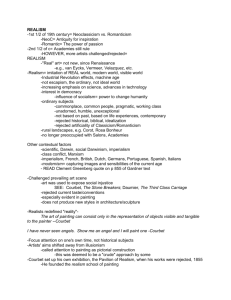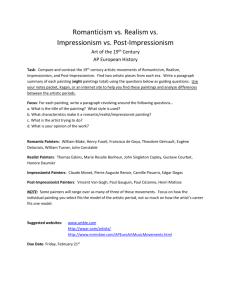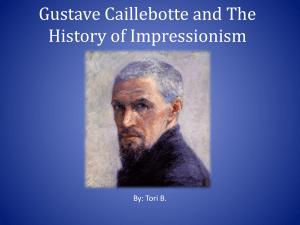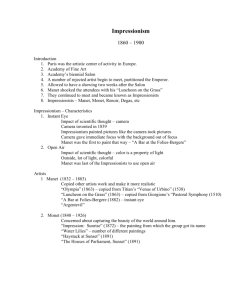"The Origins of Painting and its Representational Value". F. Leger.
advertisement
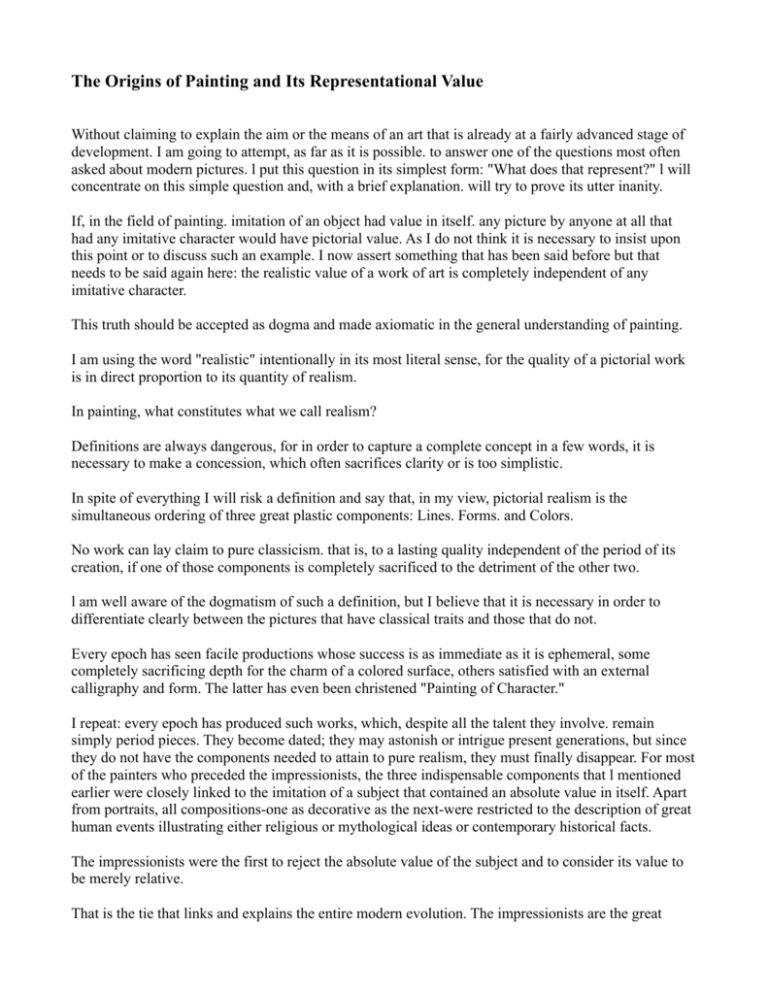
The Origins of Painting and Its Representational Value Without claiming to explain the aim or the means of an art that is already at a fairly advanced stage of development. I am going to attempt, as far as it is possible. to answer one of the questions most often asked about modern pictures. l put this question in its simplest form: "What does that represent?" l will concentrate on this simple question and, with a brief explanation. will try to prove its utter inanity. If, in the field of painting. imitation of an object had value in itself. any picture by anyone at all that had any imitative character would have pictorial value. As I do not think it is necessary to insist upon this point or to discuss such an example. I now assert something that has been said before but that needs to be said again here: the realistic value of a work of art is completely independent of any imitative character. This truth should be accepted as dogma and made axiomatic in the general understanding of painting. I am using the word "realistic" intentionally in its most literal sense, for the quality of a pictorial work is in direct proportion to its quantity of realism. In painting, what constitutes what we call realism? Definitions are always dangerous, for in order to capture a complete concept in a few words, it is necessary to make a concession, which often sacrifices clarity or is too simplistic. In spite of everything I will risk a definition and say that, in my view, pictorial realism is the simultaneous ordering of three great plastic components: Lines. Forms. and Colors. No work can lay claim to pure classicism. that is, to a lasting quality independent of the period of its creation, if one of those components is completely sacrificed to the detriment of the other two. l am well aware of the dogmatism of such a definition, but I believe that it is necessary in order to differentiate clearly between the pictures that have classical traits and those that do not. Every epoch has seen facile productions whose success is as immediate as it is ephemeral, some completely sacrificing depth for the charm of a colored surface, others satisfied with an external calligraphy and form. The latter has even been christened "Painting of Character." I repeat: every epoch has produced such works, which, despite all the talent they involve. remain simply period pieces. They become dated; they may astonish or intrigue present generations, but since they do not have the components needed to attain to pure realism, they must finally disappear. For most of the painters who preceded the impressionists, the three indispensable components that l mentioned earlier were closely linked to the imitation of a subject that contained an absolute value in itself. Apart from portraits, all compositions-one as decorative as the next-were restricted to the description of great human events illustrating either religious or mythological ideas or contemporary historical facts. The impressionists were the first to reject the absolute value of the subject and to consider its value to be merely relative. That is the tie that links and explains the entire modern evolution. The impressionists are the great originators of the present movement; they are its primitives in the sense that, wishing to free themselves from the imitative aspect, they considered painting for its color only, neglecting all form and all line almost entirely. The admirable work resulting front this conception necessitates comprehension of a new kind of color. Their quest for real atmosphere even then treated the subject as relative: trees, houses merge and are closely interconnected, enveloped in a colored dynamism that their methods did not yet allow them to develop. The imitation of the subject that their work still involves is thus, even then, no more than a pretext for variety, a theme and nothing more. For the impressionists a green apple on a red rug is no longer the relationship between two objects, but the relationship between two tones, a green and a red. When this truth became formulated in living works, the present movement was inevitable. I particularly stress this epoch of French painting, for I think it is at this precise moment that the two great pictorial concepts, visual realism and realism of conception, meet-the first completing its ascent, which includes all traditional painting down to the impressionists, and the second, realism of conception, beginning with them. The first, as I have said, demands an object, a subject, devices of perspective that are now considered negative and antirealistic. The second, dispensing with all this cumbersome baggage. has already been achieved in many contemporary pictures. One painter among the impressionists. Cézanne, understood everything that was incomplete in traditional painting. He felt the necessity for a new lom1 and draftsmanship closely linked to the new color. All his life and all his work were spent in this search. I will borrow some observations from Emile Bernard's extremely well-documented book about the Master of Aix, and also some thoughts drawn from Cézanne's own conception. "His optics," says Bernard, "were much more in his brain than in his eyes." He overinterpreted what he saw; in short, what he made came completely from his own genius and if he had had creative imagination, he would have been able to spare himself from going to "the motif," as he called it, or from placing still-life arrangements in front of himself. In Cézanne’s letters I notice ideas like these: "Objects must turn. recede, and live. I wish to make something lasting from impressionism, like the art in museum's"; and further on, he writes something that supports what I said earlier, "For an impressionist, to paint after nature is not to paint the object, but to express sensations." He wept with despair before SignoreIli's drawings and exclaimed: “I have been unable to realize. I remain the primitive on the road l have discovered." In his moments of doubt and depression, Cézanne from time to time reverted to a belief in the necessity of ancient forms. He haunted the museums, he studied the methods of expression of the painters who had preceded him; he made copies, hoping in this way to find what his restless sensibility sought. His work, beautiful and admirable as it is, frequently bears the mark of this restlessness. He saw the danger of that culture. He understood that it is perilous to look back and that the traditional value of a work of art is personal and subjective. Moreover, he wrote in one of his letters (l quote): "After having looked at the old masters. one must make haste to leave them and to verily in one's self the instincts, the sensations that dwell in us." This observation by the great painter deserves careful study. Every painter, when confronting works based on traditional conceptions, must guard his personality. He must look at them, study them, but in a wholly objective way. He must dominate and analyze them but not be consumed by them; it is the amateur in art who abandons his own personality for one imposed by the work. The artist must always be in harmony with his own time and in this way counterbalance the entirely natural need for varied impressions. In the history of modern painting Cézanne will occupy the place that Manet held some years before him. Both were transitional painters. Manet, through his investigations and his own sensibility, gradually abandoned the methods of his predecessors to arrive at impressionism, and he is unquestionably its great creator. The more one examines the work of these two painters, the more one is struck by the historical analogy between them. Manet was inspired by the Spanish, by Velasquez, by Goya, by the most luminous works, to arrive at new forms. Cézanne finds a color and, unlike Manet, struggles in the pursuit of a structure and form that Manet has destroyed and that he feels is absolutely necessary to express the great reality. All the great movements in painting, whatever their direction, have always proceeded by revolution, by reaction, and not by evolution. Manet destroyed in order to arrive at his own creative principle. Let us go back further. The painters of the eighteenth century, too sensuous and too mannered, were succeeded by David, Ingres, and their followers, who reacted by excessive use of the opposite formulas. As this movement ended in an equivalent excess, it made Delacroix necessary. Breaking violently with the preceding notion. he returned to sensuality in color and to powerful dynamism in forms and draftsmanship. These examples will be enough to illustrate clearly that the modern concept is not a reaction against the impressionists' ideas but is, on the contrary, a further development and expansion of their aims through the use of methods they neglected. Divisionism in color, however tentative it was, nevertheless exists in the impressionists' work, and it is being followed not by a static contrast hut by a parallel exploration of divisionism in form and line. And so the impressionists' work is not the end of a movement, but rather the beginning of another. which is being continued by the modern painters. The relationships among volumes, lines, and colors will prove to be the springboard for all the work of recent years and for all the influence exerted on artistic circles both in France and abroad. From now on, everything can converge toward an intense realism obtained by purely dynamic means. Pictorial contrasts used in their purest sense (complementary colors, lines, and forms) are henceforth the structural basis of modern pictures. As was true of painters before the impressionists, northern artists will still tend to seek their dynamic means through the development of color while southern painters will probably give great importance to forms and lines. This understanding of contemporary painting, born in France, is founded on a universally valid concept that permits the development of all sensibilities; the Italian futurist movement is one proof of this. Logically the picture is going to become larger, and output must be limited. Every dynamic tendency must inevitably move toward an enlargement of the means in order to be able to achieve its full expression. Many people are patiently awaiting the end of what they call a phase in the history of art; they are waiting for something else, and they think that modern painting is passing through a stage, a necessary one perhaps, but that it will return to what is commonly called "painting for everyone." This is a very great mistake. When an an like this is in possession of all its means, which enable it to achieve absolutely complete works, it is bound to be dominant for a very long time. I am convinced that we are approaching a conception of art as comprehensive as those of the greatest epochs of the past: the same tendency to large scale, the same collective effort. This last remark warrants lengthy consideration. It is important. Most French literary and artistic movements have generally manifested themselves in the same way. It is proof of their great vitality and the power of dissemination. One may cast doubt on an isolated creative work, but the vital proof of its validity is established when it is translated collectively into very distinct means of personal expression. The sentimental notion in plastic art is certainly the one closest to the heart of the great majority. The old masters, besides achieving purely plastic qualities, were obliged to satisfy this need with their pictures and to fulfill a complex social task. They had to assist architecture in its popular expressiveness and provide literary values suitable to instruct, educate, and amuse the people. To this end they illustrated churches, public buildings, and palaces with decorative frescoes and pictures representing the great deeds of humanity. Descriptive quality was a necessity of the age. For painters, living like everyone else in an age neither more nor less intellectual than preceding ones, merely different, in order to impose a similar way of seeing and to destroy everything that perspective and sentimentalism had helped to erect, it was necessary to have something else besides their audacity and their individual conception. If the age had not lent itself to this-I repeat, if their art had not had an affinity with its own time and had not been an evolution deriving from past epochs-it would not have been able to survive. Present-day life, more fragmented and faster moving than life in previous eras, has had to accept as its means of expression an art of dynamic divisionism; and the sentimental side, the expression of the subject (in the sense of popular expression), has reached a critical moment that must be clearly defined. In order to find a comparable period, I will go back to the fifteenth century, the time of the culmination and decline of the Gothic style. During this entire period, architecture was the great means of popular expression; the basic structure of cathedrals had been embellished with every lifelike ornament that the French imagination could discover and invent. But the invention of printing was bound to revolutionize and change totally these means of expression. I quote the famous passage from Victor Hugo`s Hunchback of NotreDame, from the chapter "This Will Kill That": "In the fifteenth century, human thought discovered a way of perpetuating itself not only more durable and more lasting than architecture but also simpler and easier: Orpheus`s letters of stone were replaced by Gutenberg`s letters of lead. "The book is going to kill the building." Without attempting to compare the present evolution, with its scientific inventions, to the revolution brought about at the end of the Middle Ages by Gutenberg`s invention, in the realm of humanity`s means of expression. I maintain that modern mechanical achievements such am color photography, the motion-picture camera, the profusion of more or less popular novels, and the popularization of the theaters have effectively replaced and henceforth rendered superfluous the development of visual, sentimental, representational, and popular subject matter in pictorial art. l earnestly ask myself how all those more or less historical or dramatic pictures shown in the French Salon can compete with the screen of any cinema. Visual realism has never before been so intensely captured. Several years ago one could still argue that at least moving pictures lacked color, but color photography has been invented. "Subject" paintings no longer have even this advantage; their popular side, their only reason for existence, has disappeared, and the few workers who used to be seen in museums, planted in front of a cavalry charge by M. Detaille or a historical scene by M. J.-P. Laurens, are no longer there; they are at the cinema. The average bourgeois also-the small merchant who fifty years ago enabled these minor local and provincial masters to make a living-now has completely dispensed with their services. Photography requires fewer sittings than portrait painting, captures a likeness more faithfully, and costs less. The portrait painter is dying out. and the genre and historial painters will die out too-not by a natural death but killed off by their period. This will have killed that. Since the means of expression have multiplied, plastic art must logically limit itself to its own purpose: realism of conception. (This was horn with Manet, developed by the impressionists and Cézanne, and is achieving wide acceptance among contemporary painters.) Architecture itself, stripped of all its representational trimmings, is approaching a modern and utilitarian conception after several centuries of false traditionalism. Architectural art is confining itself to its own means-the relationship between lines and the balance of large masses; the decorative element itself is becoming plastic and architectural. Each art is isolating itself and limiting itself to its own domain. Specialization is a modern characteristic, and pictorial art, like all other manifestations of human genius, must submit to its law; it is logical, for by limiting each discipline to its own purpose, it enables achievements to be intensified. In this way pictorial art gains in realism. The modern conception is not simply a passing abstraction, valid only for a few initiates; it is the total expression of a new generation whose needs it shares and whose aspirations it answers. Montjoie!, Paris, 1913
